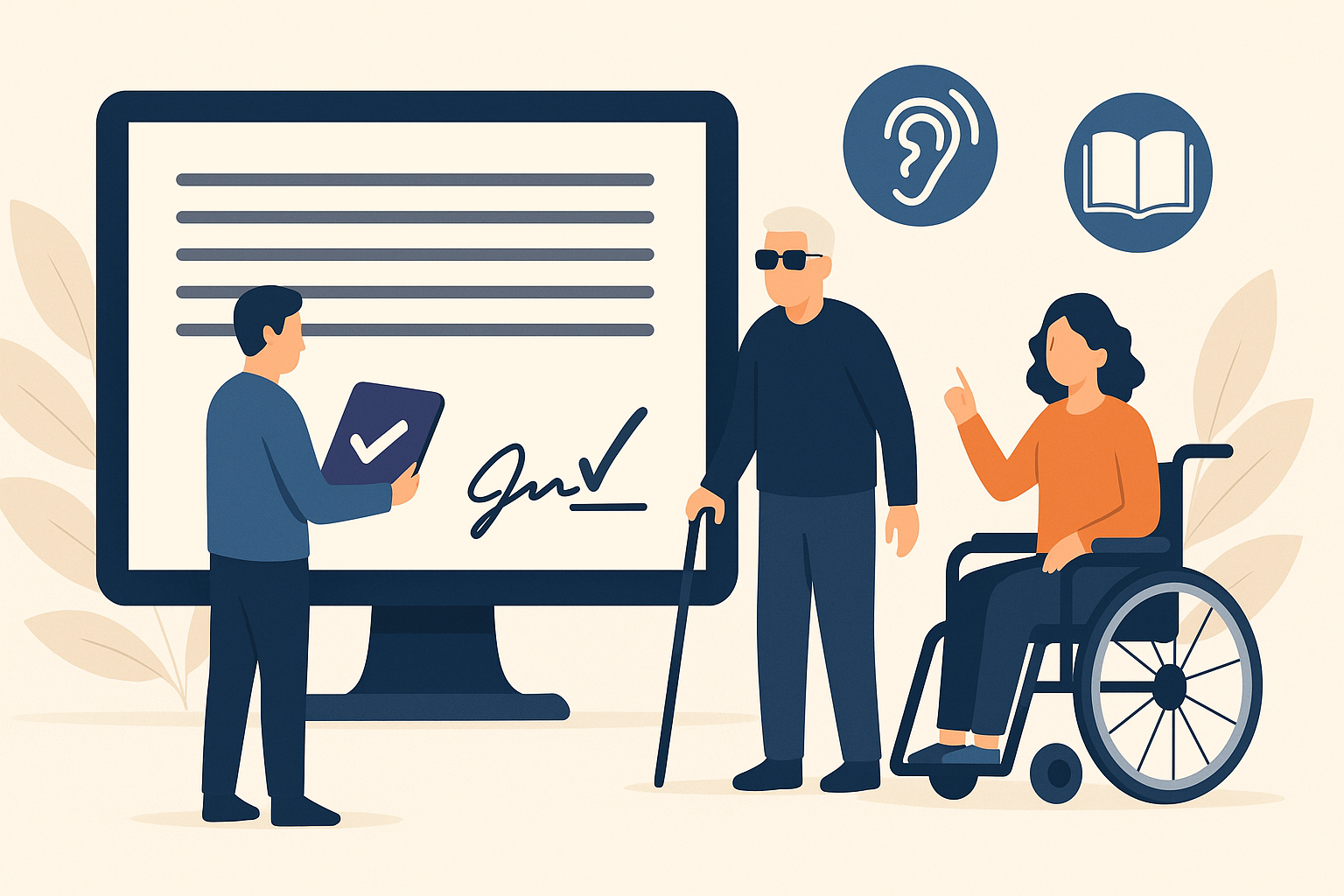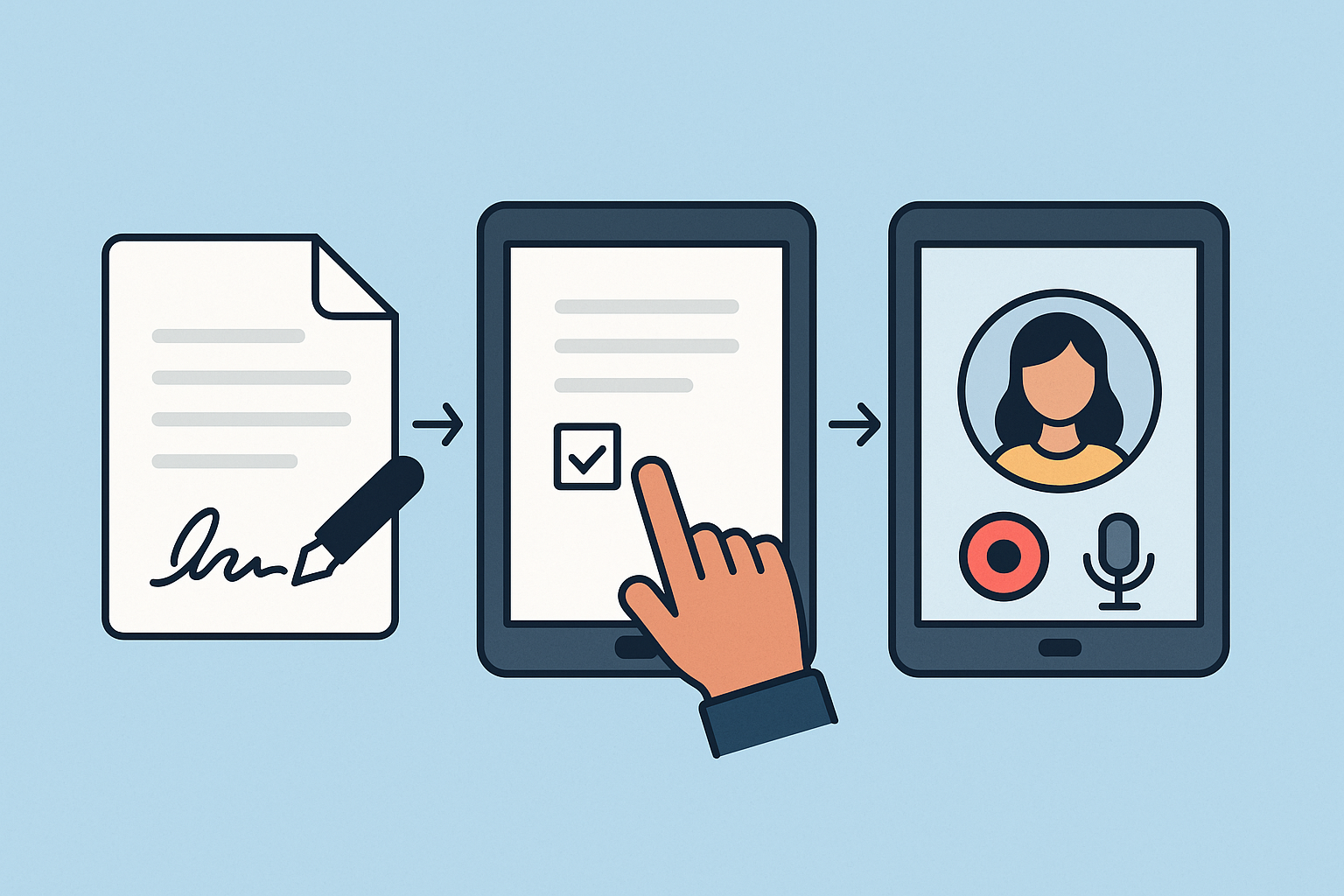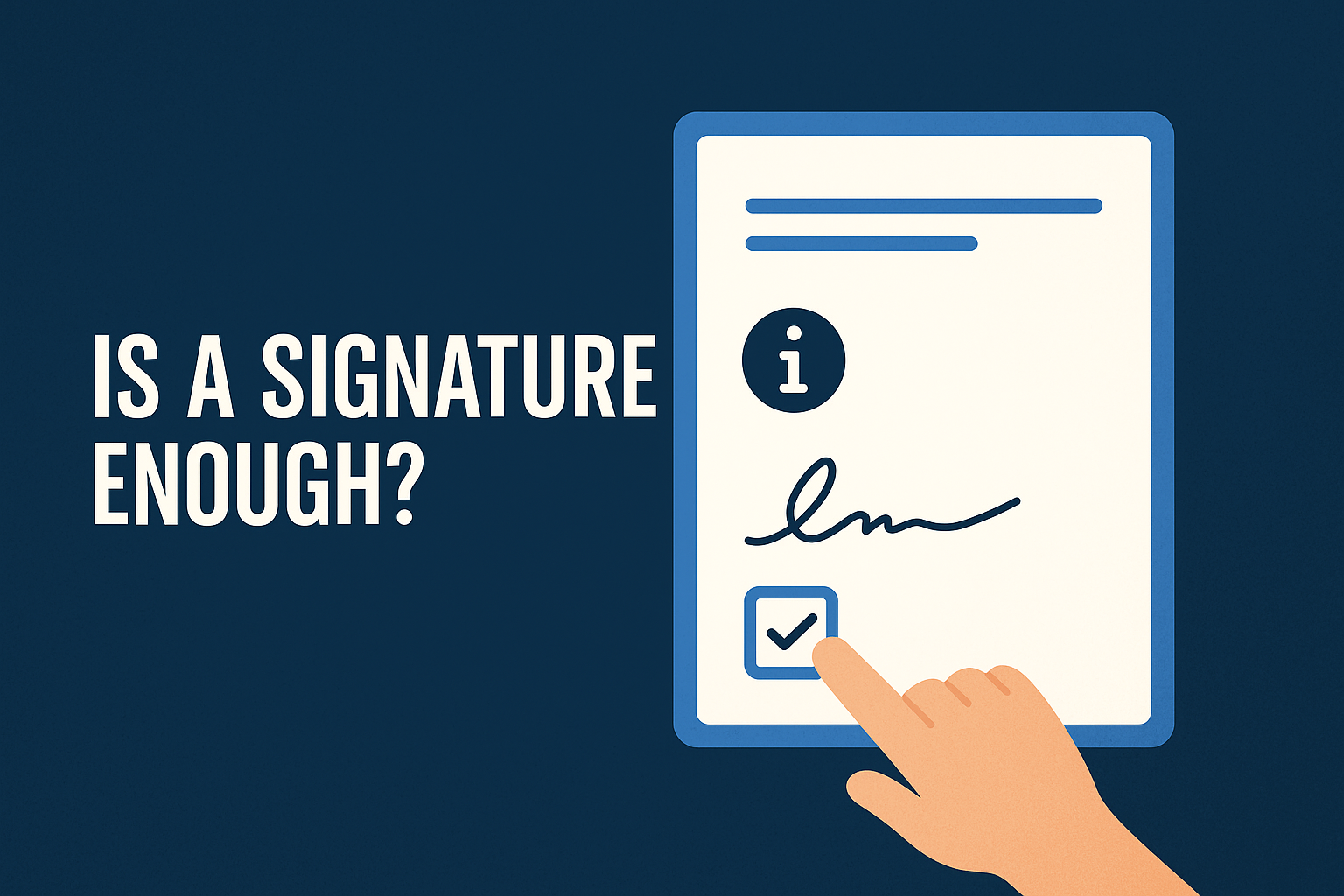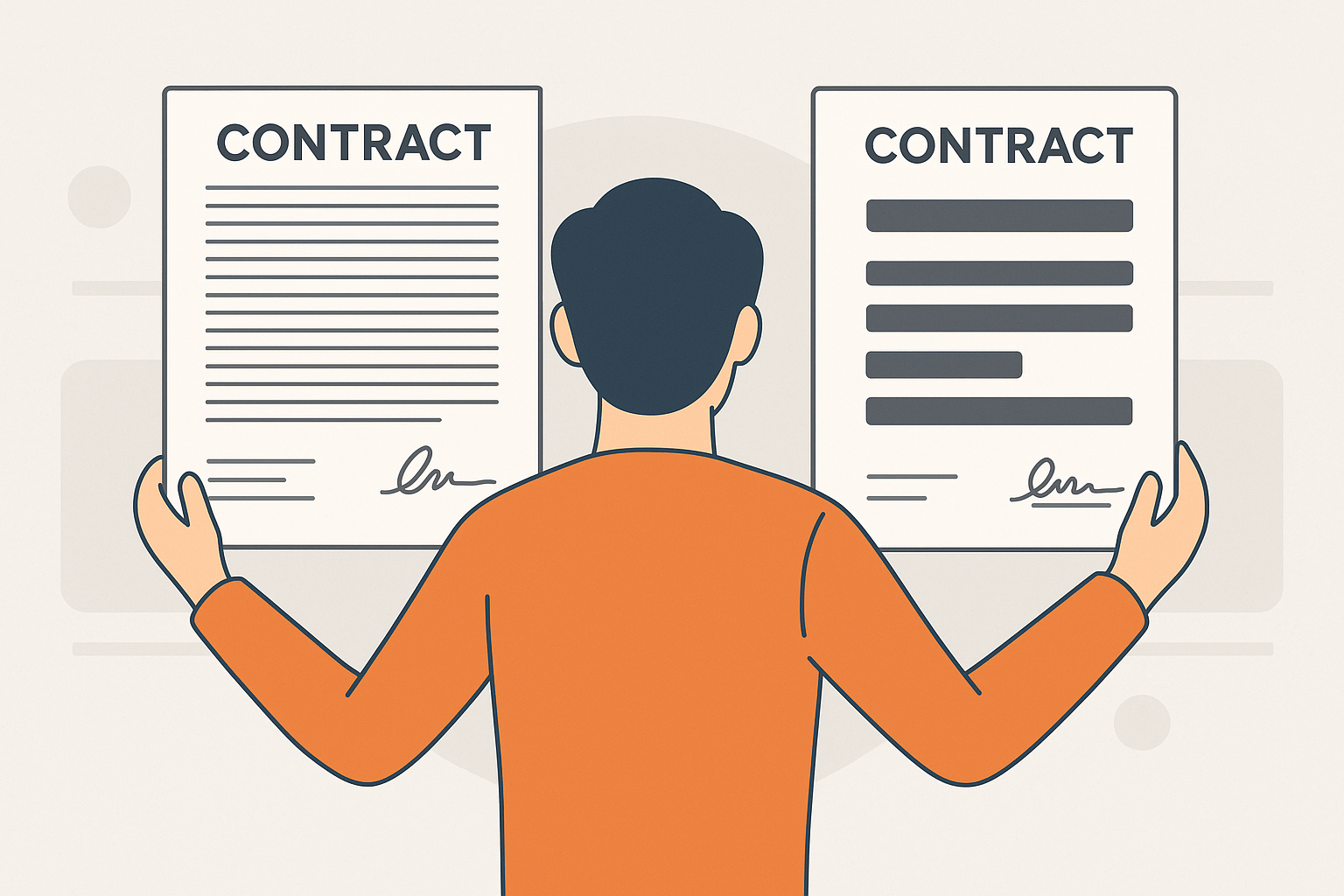How “accessible” are your digital contracts, really? Many organizations proudly adopt digital signing solutions or contract platforms advertised as “accessible,” then add an e-signature button, believing the job is done. But true accessibility goes far beyond converting paper to PDF or ticking a compliance box. If a large segment of your customers can’t understand or navigate your contract process, then it isn’t truly accessible. In this post, we’ll explore the hidden barriers that prevent people from engaging with contracts, where most platforms fall short, and how applying universal design principles can ensure everyone – regardless of literacy, language, or neurodiversity – can confidently say “I agree”.
What this blog contains:
- Hidden Barriers in Digital Contracts
- What Most Platforms Get Wrong
- Universal Design: One Process for All
- Features of an Inclusive Contract Platform
- Benefits of Accessibility for All
- Leading the Way with Inclusive Legal Tools
Hidden Barriers in Digital Contracts
Digital contract processes often assume that every user can read and understand lengthy legal text – an assumption that leaves many people behind. In reality, numerous hidden barriers can prevent someone from fully grasping a contract:
- Low literacy: A significant portion of adults struggle with reading complex text. For example, about 1 in 6 adults in England have “very poor” literacy skills. Yet few will openly admit difficulty, so they end up facing the same dense documents as everyone else, without extra support.
- Language differences: In today’s diverse world, many users aren’t native speakers of the contract’s language. Over 7% of the UK population doesn’t speak English as a main language. These individuals might quietly nod along rather than reveal they’re confused by an English-only agreement.
- Neurodiversity and learning differences: Conditions like dyslexia (affecting roughly 1 in 10 people) or ADHD can make it hard to parse long, text-dense documents. These cognitive differences are often invisible – users might not disclose them – but they can significantly impact one’s ability to absorb complex information. An e-signature process that simply dumps a huge document in front of the signer with no additional support can be especially daunting for these users.
- Lack of legal knowledge or confidence: Even highly educated people can feel lost when confronted with legal jargon and formal contract language. Traditional contracts assume a very high reading level and familiarity with legal terms, which excludes many users by default.
Because these barriers are usually hidden, users rarely ask for special accommodations. A client with low literacy or other challenges is unlikely to raise their hand and request a simplified contract – often due to embarrassment or fear of judgment. The result is that many signers simply “get by” or click “agree” without fully understanding what they’re agreeing to. This isn’t just a personal issue; it’s a systemic problem with how contracts are presented.
What Most Platforms Get Wrong
Too often, “accessibility” in contract platforms is treated as an afterthought or a separate, specialized process. If a user has trouble, the solution might be offering a different version or a human assistant – but only if the user explicitly asks for help. Most platforms effectively say, “Here’s the standard contract for most people, and if you can’t handle it, we have an accessible option somewhere.” This approach is flawed. In reality, the alternative path (if it exists at all) is usually underutilized or ineffective. Many companies don’t even offer simplified contracts, and among those that do, very few make them readily available to users.
In practice, the majority of digital signing solutions – even those marketed as accessible contract platforms – simply replicate old paper forms in electronic form. In fact, most digital contracts today are just static PDFs with a scribble signature or tickbox on top – a 17th-century paper ritual dressed up in 21st-century clothing. They might look modern, but the content remains lengthy, jargon-filled, and difficult to navigate. Studies back this up: one landmark analysis of 500 popular websites found over 99% of their user agreements were essentially unreadable to the average person. The average terms of service was written at a level comparable to an academic journal, requiring more than 14 years of education to fully comprehend. It’s no wonder that only about 9% of adults actually read online terms and policies before clicking “I agree” – the rest skip it because the text is just too long and complex.
In short, most e-signature and contract platforms focus on getting the signature, not on ensuring understanding. They offer a one-size-fits-all, text-heavy workflow and consider their job done. Technical accessibility (like screen reader compatibility or font size options) might be addressed, but cognitive accessibility – making the content clear and usable for everyone – is largely overlooked. This is where traditional platforms get it wrong: they prioritize form over understanding. For instance, neurodiversity in e-signature design is usually overlooked – the standard scroll-and-sign interface assumes everyone processes information the same way, which just isn’t true.
Universal Design: One Process for All
True accessibility means creating a single, inclusive process that works for everyone, rather than a separate “normal” and “special” version. This is the philosophy of universal design – an approach originally born in fields like architecture but just as powerful in digital services. When we say contracts should follow universal design, we mean building understanding into the default experience for every user, not bolting on fixes later for those who struggle.
A useful analogy is the “curb cut effect” from city design. Sidewalk curb ramps were initially installed for wheelchair users, but ended up benefiting many others – parents with strollers, travelers with luggage, cyclists, and more. In other words, solving for the needs of people with disabilities improved convenience for everyone. The same principle applies to contracts and legal communication. If we design contract workflows to accommodate low literacy, non-native speakers, or neurodivergent users, the process becomes easier for all users. Simplifying language, adding visual aids, and breaking information into digestible pieces doesn’t only help the most vulnerable; busy professionals and well-educated users appreciate clarity too. No one ever complained that a contract was too easy to understand!
As one accessibility advocate noted, challenges like low literacy or neurodivergent thinking are often “hidden disabilities,” and making a product accessible inherently makes it more inclusive for everyone. This is the core of inclusive design. By lowering the comprehension barrier, we raise overall understanding for all participants. Universal design in digital contracts means we stop expecting users to adapt to archaic, difficult documents and instead adapt our documents to the diverse needs of users. The goal is to have one journey that everyone can follow confidently, without anyone being singled out or left behind.
Features of an Inclusive Contract Platform
What would a truly inclusive, accessible contract platform look like? It would incorporate design features that make the process understandable and usable for as broad a range of people as possible, by default. Instead of waiting for someone to say “I’m confused, I need help,” the platform itself would proactively support comprehension. Key features might include:
- Plain language content: Minimize legal jargon and write terms in clear, everyday language. If technical terms or complex clauses must be included, provide instant plain-language explanations or definitions alongside the text. No one should need a law degree to decipher an agreement.
- Multiple formats for key information: Not everyone absorbs information best by reading text. An inclusive platform could offer a short video or audio summary of the contract’s main points, giving a conversational overview to reinforce the written document. Visual aids like charts or icons can highlight important details. By engaging multiple senses (visual, auditory), you cater to different learning styles and improve overall retention.
- Interactive understanding checks: Instead of a passive “scroll and sign” experience, the platform can include brief interactive elements to confirm the user’s understanding. For example, a few multiple-choice questions or prompts might appear at intervals: “Which of these is your main obligation under this contract?” Or the user could be asked to verbally confirm key points via their microphone. This turns a one-way disclosure into a two-way conversation and ensures the user is actively processing the content.
- Just-in-time help, available to all: In an inclusive design, support is built in for anyone to access discreetly. Users might click a “?” icon next to a clause to see a simpler explanation, or open a sidebar FAQ for common questions. They could even chat with a support agent or intelligent assistant for clarification. The crucial point is that these aids are available to everyone, without stigma. The user who needs extra help can take it anonymously; the user who doesn’t need it can simply ignore it.
- Multi-language and reading accommodations: If your user base speaks different languages, an accessible platform lets them switch the contract text to their preferred language with one click. Likewise, it would offer accessibility settings like a dyslexia-friendly mode (e.g. a special font or background color that makes reading easier) as a built-in option. These should not require any special request — they’re just part of the standard interface. By embedding such features into the main product, you ensure everyone has a fair chance to understand the terms in a way that suits them.
All these elements “bake in” accessibility from the start, rather than treating it as an add-on. The contract experience becomes flexible, adapting to different user needs without anyone having to ask for a “special” version. When done right, inclusion isn’t a feature – it’s the foundation of the entire approach. Every user, from a seasoned lawyer to a first-time customer with reading challenges, goes through the same core process and arrives at the same outcome: genuine understanding of the agreement.
Benefits of Accessibility for All
Designing contracts with accessibility and clarity in mind isn’t just altruism – it delivers tangible benefits to both users and organizations. For users, the advantages are clear: they have a far better experience, with less frustration and uncertainty. People actually know what they’re signing. They feel respected and empowered rather than overwhelmed. This builds trust. Clients are more comfortable proceeding when they truly understand the deal, and they’re less likely to be surprised later by “fine print” they missed.
The business gains are significant as well. Fewer misunderstandings upfront mean fewer complaints and disputes down the line. Misunderstandings are one of the most common causes of customer complaints, so eliminating confusion preempts a lot of problems. Clear communication leads to fewer contract disputes and less time spent by staff resolving issues, which saves money and protects reputations. It also strengthens client relationships – a customer who feels informed is more likely to stay loyal and satisfied.
An accessible contract process also reduces legal and compliance risks. When someone truly gives informed consent, there’s less room for them to later claim “I didn’t know what I was signing.” Organizations that use plain language, interactive confirmations, and other inclusive practices can demonstrate that each user had every opportunity to understand the terms. This makes agreements more defensible if they’re ever challenged. In fact, regulators are starting to expect this level of clarity. Recent rules – such as the UK Financial Conduct Authority’s new Consumer Duty – emphasize that firms must ensure customer understanding, not just collect signatures. Privacy laws like GDPR similarly require consent to be informed and unambiguous, putting the onus on businesses to communicate terms intelligibly. Simply put, the writing is on the wall: the era of “tick-box” consent is ending, and transparent, user-friendly agreements are the new standard.
Finally, making your contracts accessible to all is just good business. When people find the signing process easy and clear, they are more likely to complete it rather than abandon it midway. You also widen your potential customer base – fewer people are alienated or excluded by a daunting contract. And the innovations that improve accessibility (videos, summaries, Q&A, etc.) tend to streamline the experience for everyone, not just those who might strictly “need” them. It’s a win-win: better user experience, better compliance, and often faster deal closures. As one of our other posts put it, “Confusion is expensive. Clarity is far cheaper. It builds trust, reduces risk and helps businesses stay on the right side of regulators and clients alike.”
Leading the Way with Inclusive Legal Tools
Reimagining the contract experience along these inclusive lines might sound like a tall order – but it’s exactly what we’ve set out to do at  i agree. Rather than retrofit accessibility onto an old system, we built our platform from the ground up with universal design in mind. Our philosophy, as stated in our Our Principles, is that accessibility should be built in, not bolted on. Every signer, regardless of background or ability, goes through one seamless process that helps them understand and agree with confidence.
i agree. Rather than retrofit accessibility onto an old system, we built our platform from the ground up with universal design in mind. Our philosophy, as stated in our Our Principles, is that accessibility should be built in, not bolted on. Every signer, regardless of background or ability, goes through one seamless process that helps them understand and agree with confidence.
 i agree takes advantage of modern technology to make agreements clearer, safer, and more human. For instance, users can watch a short summary video of what they’re agreeing to, instead of wading straight into text. Important terms are highlighted and accompanied by plain-language explanations, so there’s no need to guess at legal jargon. The interface is interactive – it can prompt users with questions or ask for a quick confirmation to ensure key points are understood. Signers can even provide a verbal confirmation of acceptance, recorded via their webcam or phone, adding an extra layer of understanding and authentication. Throughout the process, help is always at hand: a user can click to see definitions, ask questions, or switch to a different language at any point, without ever feeling like they are leaving the standard workflow. This essentially creates a neurodiversity-friendly e-signature process – one that adjusts to different ways people think and learn, instead of forcing everyone into the same mold.
i agree takes advantage of modern technology to make agreements clearer, safer, and more human. For instance, users can watch a short summary video of what they’re agreeing to, instead of wading straight into text. Important terms are highlighted and accompanied by plain-language explanations, so there’s no need to guess at legal jargon. The interface is interactive – it can prompt users with questions or ask for a quick confirmation to ensure key points are understood. Signers can even provide a verbal confirmation of acceptance, recorded via their webcam or phone, adding an extra layer of understanding and authentication. Throughout the process, help is always at hand: a user can click to see definitions, ask questions, or switch to a different language at any point, without ever feeling like they are leaving the standard workflow. This essentially creates a neurodiversity-friendly e-signature process – one that adjusts to different ways people think and learn, instead of forcing everyone into the same mold.
This “one journey for all” approach isn’t just theory; it’s working in practice. As we discussed in our blog post Accessibility is inclusion: One process for everyone, forward-thinking platforms like  i agree have reimagined the traditional contract signing process to make it clearer, safer, and more human – using videos, guided walkthroughs, and even selfies as verification – all within a single flow any user can navigate. “Vulnerable” clients no longer have to be treated separately, because the mainstream process itself is accommodating. And when
i agree have reimagined the traditional contract signing process to make it clearer, safer, and more human – using videos, guided walkthroughs, and even selfies as verification – all within a single flow any user can navigate. “Vulnerable” clients no longer have to be treated separately, because the mainstream process itself is accommodating. And when  i agree helps a business demonstrate that each customer truly knew what they were signing, it’s not just meeting compliance requirements, it’s exceeding them. (For more on why good UX/UI design matters for contracts, see our post UI/UX: What it is, and why it’s crucial.)
i agree helps a business demonstrate that each customer truly knew what they were signing, it’s not just meeting compliance requirements, it’s exceeding them. (For more on why good UX/UI design matters for contracts, see our post UI/UX: What it is, and why it’s crucial.)
In the end, making your digital contracts truly accessible is about respecting your users and protecting your organization. It means showing that every client’s consent matters, and proving it by designing a process everyone can navigate. Platforms like  i agree are pioneering this inclusive approach, transforming contracts from mere formalities into transparent, mutual understandings. The payoff is fewer complaints, stronger trust, and agreements that hold up because everyone genuinely understands them. It’s time to leave behind the old mindset of “read at your own risk” contracts. With inclusive design and the right tools, we can ensure that “I agree” truly means “I understand.”
i agree are pioneering this inclusive approach, transforming contracts from mere formalities into transparent, mutual understandings. The payoff is fewer complaints, stronger trust, and agreements that hold up because everyone genuinely understands them. It’s time to leave behind the old mindset of “read at your own risk” contracts. With inclusive design and the right tools, we can ensure that “I agree” truly means “I understand.”
Learn more about our mission and approach on our Our Principles page, check out our FAQs for common questions, or read how clear communication can reduce disputes in our post Clear communication: the key to fewer complaints and disputes. An accessible future of digital contracting is within reach – and we’re building it, one informed consent at a time.




